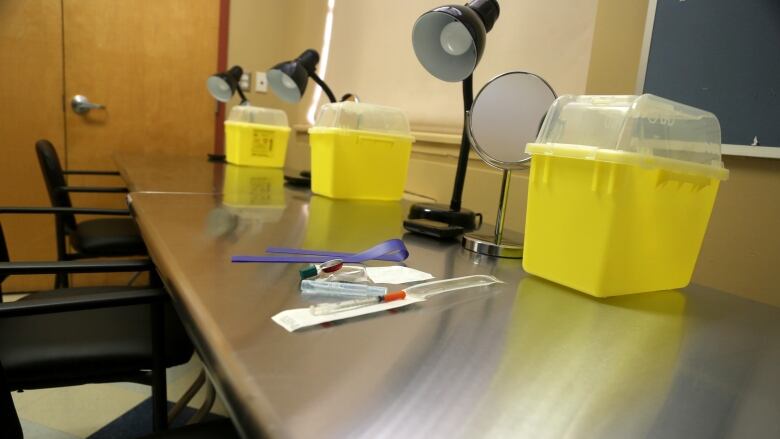Beat opioid crisis with safe drugs and places to use them, says forum
Local health-care and harm reduction workers say Hamilton needs a new approach to the opioid crisis

If we want fewer overdose deaths in Hamilton, drug users need access to a safe supply of drugs and more places to consume them,local health-care and harm-reduction workers said on Tuesday.
Part of a two-day forum called Getting to Tomorrow: Ending the Overdose Crisis, the group gathered online to identify policy solutions to the overdose crisis. Hamilton saw 105 opioid-related deaths in 2019 and 124 last year. By February of this year, there had already been26 more.
While there is one safe injection site in Hamilton, run by the Hamilton Urban Core Community Health Centre at St. Paul's Presbyterian Church, participants criticized the city for the delay in opening a second promised "consumption and treatment services" site. The city said in 2019 that it had found a location in the area of Hamilton "most impacted by the opioid crisis," but didn't give specifics.
"It's a shameful issue that we haven't been able to find a second space," said Dr. Tim O'Shea, who works with patients addicted to drugs.
Jody Ans a harm reduction worker with the AIDS Network and Keeping Six, which advocates on behalf of drug users says the community took Hamilton public health at its word when it said it was committed to opening a site. But he's losing faith.
"If the city can't get a space, who can?" he said. "It was over a year now and we're still waiting."
The city's medical officer of health Dr. Elizabeth Richardson says the city has been working to open a new CTS site "operated either through a community agency or by the city directly" but has not been able to secure a location.
"Public Health Servicesunderstands there are community agencies that are pursuing applications for CTS sites, and we continue to work alongside these groups to provide any information or linkages to our services as they make their applications," she told CBC Hamilton in an email on Tuesday.
Meanwhile, the Urban Core site that will eventually relocate to a new home at 430 Cannon St. E. is being protested by Ward 3 residents, who have formed a group called SAFE: Safety and Accountability For Everyone.
"Despite being a city of over 500,000 people, we have one consumption and treatment site, a small informal safe supply that only serves about 20 patients, and a group of Hamilton residents who are fighting the relocation of the consumption and treatment site to their neighbourhood," said a press release issued by the organizers of Tuesday's event, quoting Keeping Six outreach coordinator Marcie McIlveen.
New opioids are a complex mix
While there was a range of opinions Tuesday on who should be able to access a safe supply of drugs, and how it should be delivered, there seemed to be consensus that such a supply is critical to preventing overdose deaths. Ans described new synthetic opioids he's seeing on the streets that are further complicating overdose treatment.
"You can go from being fine to dead fairly quickly if the people around you don't know," he said. "The opioids themselves are not strong, but it's the combination of chemicals. Some have fentanyl, carfentanil and two types of (benzodiazepines) when you analyze them."
O'Shea pointed out there is no funded clinic that offers a safe supply of drugs, and only a small, informal network of doctors willing to prescribe them.
"There's very few (doctors) and it's probably not well known," he said. "There is a lack of a safe supply program here The main barrier is a lack of willing prescribers."
YWCA director of operations Medora Uppal, who sits on the city's drug strategy steering committee, says she sees a similar resistance to the idea in her circles.
Safe supply saves lives, one doctor says
"I don't think there has been as many conversations as there should be about safe supply," she said. "There hasn't been a big embrace of it in the medical community. Agencies who might be able to support safe supply access for individuals who are using their services haven'thad discussions about it.
"There's a lot of resistance to it, and it's not clear why People are more worried about people getting the safe supply and redistributing it, but isn't that a better harm-reduction approach if it's safe?"
What people might not realize, added O'Shea, is how much securing a source of safe drugs can help someone in many other areas of their life.
"It gives an opportunity to address a lot of people's other health issues," he said. "If my patient has their priorities which often is getting access to a safe supply so they can prevent themselves from overdose or dying then I have priorities like making sure their blood pressure is treated. Having patients on a safe supply means I can get the space to do that (and dive) into other issues like housing.
"It's led to some big gains in other areas of health becausepeople don't have to worry about chasing an unsafe drug supply."












_(720p).jpg)


 OFFICIAL HD MUSIC VIDEO.jpg)
.jpg)



























































































